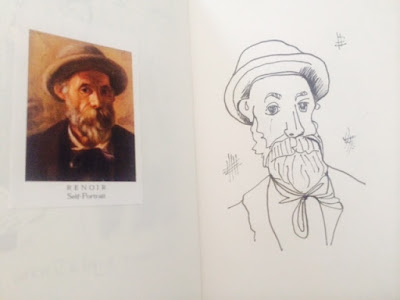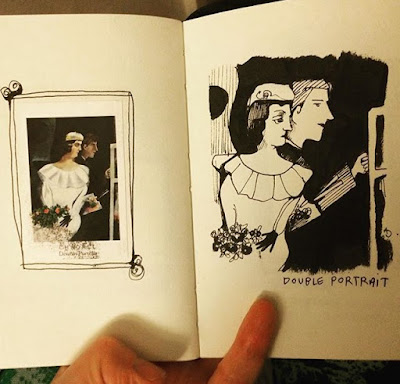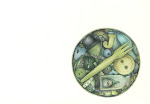I don't understand how people get bored. It's a complete mystery to me. How is it even possible when there are so many things you can do to amuse yourself? I have a million and one projects on the go that I can dip into when I have nothing else to do. My problem is those projects too often get shelved because I never have nothing else to do.
Here's one of them. I started this a little while back when my friend, designer Emily Pickle, bought me a couple of Chagall and Renoir sticker books. At the same time I'd bought a couple of cheap little sketchbooks that were on a buy one get one free offer. So I dedicated one to copying the stickers. But, copying them upside down
Now, I'd heard about this technique a long time ago, when I first started drawing. I'm sure it was through Danny Gregory but I can't be certain. I didn't really give it much of a go back then. I was too caught up in making everything look perfect, and hadn't really learnt to trust my own judgement. Anyway, I only really started playing around with the technique, properly, a few years ago. Now, I really love it and use it often. Especially with portraits.
So how does it work? Well, it's really quite simple. I'm sure many of you already know, but for those who don't (and being self taught and not having that art school background, I had never come across these techniques before hanging out with illustrators online), here's a quick demo.
As I said, I was given these little sticker books of paintings from a series by the great painters. I'm not really a Renoir fan, but that really doesn't matter at all. And, as for Chagall, well, although I knew his work I hadn't studied it until now. And now I really am a big fan. I stuck all the stickers on the left hand pages of the sketchbook. You don't need stickers though. You can use absolutely anything as subject matter.
Then what you do is you turn the book upside down. See below.
All I have used is a fine pen and then a thicker pen; like a brush pen, a calligraphy pen or anything with a thicker nib. A marker pen will work just as well although they often bleed through the paper.
I started by making a line drawing. This exercise is all about looking. Really looking. Starting in the top left hand corner and trying to copy, as best you can, the photo or image you're working from. Stop wondering if you're getting it 'right' and just keep looking. Resist the urge to turn it the right way up until you've drawn the whole image in.
THEN you can turn it around. It's never really going to be 'perfect'. There'll always be a quirkiness about your drawing, but I think that's the joy of doing this. I always find I make the eyes huge.
When I'd completed the line drawing, and turned the book around, I shade the drawing with the thicker pen. There's no reason you can't do all that while the image is still upside down. I just like brining it together like this at the end.
I've since found some more stickers of Japanese art which should complete the sketchbook (after I've shared them out with Emily Pickle, that is).
I should add that your first attempts may look absolutely nothing like the image you are copying. Mine certainly didn't. I've done a huge amount of this stuff since getting into it. But it's amazing how quickly I got better at it and how confident the drawings became. But, I guess that's the same of anything you do.
This one above, is one of my favourites.
One warning; if you do decide to dedicate a whole book to this technique, no matter how much you try, this will at some point happen...
















14 comments:
I remember the upside down drawing practice. i found it first in Betty Edwards book 'Drawing On the Right Side of the Brain.'
As a novice I drew a knoght in armor on a horse (upside down) and it was remarkably effective. love the quirky..ness of yours and what a great idea using the stickers...I love it!
Loved seeing your sticker book of upside down drawings. I first saw it in the book drawing on the Right Side of Your Brain by Betty Edwards. I did a few exercises, but never thought about it as a long project. Great idea for my Goal List for 2016.
What a neat idea! I might have to try this sometime.
I just finished your week at SBS and I LOVED it! Thanks for all the great advice and especially for inspiring me to do more with my ballpoints!
I'll probably end up with rather a lot of "bugger!" pages! But it is fun, isn't it? Like blind contour.
Super!! I'm going to give this a go....Also, are you a lefty?
Great post! I knew the technique from Edwards book also, but the idea of a whole sketchbook is awesome; and you did it beautifully
What size are the art reproductions? and what size is your book? This is something I intend to do if I can find suitable material, starting Jan 1.
that's the most inspiring thing i've seen in a long time - the creative copying, and so upside down on so many levels - Andrea, you're my absolute role model, hope you come to NYC so we can sketch together one day!
I don't get it... what's wrong with the last one?
Oh my goodness, I have not played with this exercise since college drawing courses back in the (ahem) Dark Ages. I seem to collect Moleskines with the intention of filling them up with drawings and paintings so why not dedicate one to this new/old challenge? What a great reminder to go back to a past exercise to keep those eye to brain to hand to paper senses coordinated.
Try as I might, I can't see what the problem is on the page you were "buggering" about. Someone please enlighten me.
What a brilliant idea! I also remember the exercise in Betty Edwards' book. Several years ago I spent a 2 week vacation doing every exercise in the book and it completely changed my way of seeing and drawing ceased being frustrating and tedious and became fun, even rewarding. I think I will try putting the image on my computer screen and flipping it and going from there. If one was ambitious enough the image could be copied onto cheap photo paper and glued in the sketchbook. That way you could pick exactly the paintings or drawings you wanted to copy. Holbein's portrait drawings are fun to copy as line drawings in ink. Thanks for a great post!
The copy is upside down.
This is a wonderful post, Andrea. You write so well about the process of upside down drawing and I love seeing your works. So creative to use the art stickers this way! ...I'm currently taking and enjoying your SBS klass on Lettering.
Post a Comment